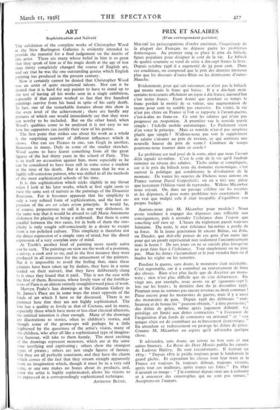ART
Sophistication and Naliveté THE exhibition of the complete works of Christopher 'Wood at the New Burlington Galleries is evidently intended to provide the material for a final judgement on the merits of this artist. There are many whose belief in him is so great that they speak of him as if his tragic death at the age of less than thirty completely changed the course of English art, and say that he was the one outstanding genius which English painting has produced in the present century.
Now it certainly cannot be denied that Christopher Wood was an artist of quite exceptional talents. Nor can it be denied that it is hard for any painter to have to stand up to the test of having all his works seen in a single exhibition, especially if that painter worked so fast that five hundred paintings survive from his hand in spite of his early death. In fact, one of the remarkable features about this show is the even level of the achievement ; there are hardly any pictures of which one would immediately say that they were not worthy to be included. But on the other hand, when Wood's qualities come to be analysed it is not easy to see how his supporters can justify their view of his genius.
The first point that strikes one about his work as a whole is the surprising number of different influences which it shows. One can see Picasso in one, van Gogh in another, Rousseau in many, Dufy in some of the smaller sketches. Wood seems to have learnt something from all the great figures of the last thirty years in the school of Paris. This is in itself no accusation against him, more especially as he can be considered to have been still in some sense a student at the time of his death. But it does mean that he was a highly self-conscious painter, who was skilled in all the methods of the most sophisticated schools of his time.
It is this sophistication which sticks slightly in my throat when I look at his later works, which at first sight seem to have the same sort of naiveté as the paintings of the Douanier Rousseau. For it becomes apparent that his simplicity is only a very refined form of sophistication, and the last ex- pression of the ars est celare artem principle. It would be, of course, preposterous to call it in any way dishonest, in the same way that it would be absurd to call Marie Antoinette dishonest for playing at being a milkmaid. But there is some parallel between the two cases, for in both of them the sim- plicity is only sought self-consciously in a desire to escape from a too polished culture. This simplicity is therefore not the direct expression of a simple state of mind, but the direct expression of a very complat state of mind.
At Tooth's another kind of painting more nearly naive can be seen. The paintings on view are the work of a postman, a navvy, a cook and so on, and in the first instance they were produced in all innocence for the amusement of the painters. But it is impossible to avoid the feeling that, since these painters have been taken up by dealers, they have in a sense traded on their naiveté, that they have deliberately clung to it since they found that it paid. This is not the case with the first of them, Rousseau, whose lovely view of the fortifica- tions of Paris is an almost entirely straightforward piece of work.
Mervyn Peakt's line drawings at the Calmann Gallery in St. James's Place are in some ways the exact opposite of the kinds of art which I have so far discussed. There is no pretence here that they are not highly sophisticated. The line has a quality as lovely as that of Cocteau, and in many, especially those which have more or less clear classical allusions, the satirical intention is clear enough. Many of the drawings are illustrations to stories, often to children's stories, and though some of the grown-ups will perhaps be a little frightened by the queerness of the artist's vision, many of the children, who after all like a sophisticated type of imagina- tive humour, will take to them keenly. The most exciting of the drawings represent monsters, which are at the same time terrifying and captivating ; others show the strangest types of pirates ; others are just single figures of fantasy. But they are all perfectly consistent, and they have the charm which comes of the fact that they stream straight apparently :tom an imagination which, though it must be in a very odd :,rate, at any rate makes no bones about its products, and, since the artist is highly sophisticated, allows his visions to
= expressed in a correspondingly sophisticated technique.
AmmoNY BLUNT.










































 Previous page
Previous page